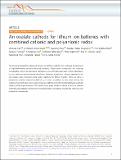An oxalate cathode for lithium ion batteries with combined cationic and polyanionic redox
Abstract
The growing demand for advanced lithium-ion batteries calls for the continued development of high-performance positive electrode materials. Polyoxyanion compounds are receiving considerable interest as alternative cathodes to conventional oxides due to their advantages in cost, safety and environmental friendliness. However, polyanionic cathodes reported so far rely heavily upon transition-metal redox reactions for lithium transfer. Here we show a polyanionic insertion material, Li2Fe(C2O4)2, in which in addition to iron redox activity, the oxalate group itself also shows redox behavior enabling reversible charge/discharge and high capacity without gas evolution. The current study gives oxalate a role as a family of cathode materials and suggests a direction for the identification and design of electrode materials with polyanionic frameworks.
Citation
Yao , W , Armstrong , A R , Zhou , X , Sougrati , M-T , Kidkhunthod , P , Tunmee , S , Sun , C , Sattayaporn , S , Lightfoot , P , Ji , B , Jiang , C , Wu , N , Tang , Y & Cheng , H-M 2019 , ' An oxalate cathode for lithium ion batteries with combined cationic and polyanionic redox ' , Nature Communications , vol. 10 , 3483 . https://doi.org/10.1038/s41467-019-11077-0
Publication
Nature Communications
Status
Peer reviewed
ISSN
2041-1723Type
Journal article
Description
Authors acknowledge financial support from the National Natural Science Foundation of China (51822210), the Australian Research Council (ARC) for its support through Discover Project (DP 140100193),Shenzhen Peacock Plan (KQJSCX20170331161244761), the Program for Guangdong Innovative and Entrepreneurial Teams (No. 2017ZT07C341), and the Development and Reform Commission of Shenzhen Municipality for the development of the “Low-Dimensional Materials and Devices” discipline.Collections
Items in the St Andrews Research Repository are protected by copyright, with all rights reserved, unless otherwise indicated.

